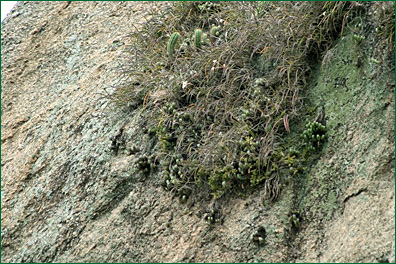
| by Delfina de Araujo |
|
Rio
de Janeiro is a city that, in spite of having its nature under attack
without interruption since the discovery of Brazil, succeeded in resisting
bravely and, often, we are surprised with pleasant nooks inserted in areas
of quite high density of population. When we try to get more information
about the history of the area, we become more astonished because it could
be, in the past, a devastated area which is, today, in process of recuperation
due to the great endeavor of a group formed by people and entities interested
in the preservation of the environment. Going on the survey about the orchids from Leme Hill, I came across to a case like this. |
|
This is the history of Environmental Protected Area of Leme Hill (Área
de Proteção Ambiental do Morro do Leme "APA do Morro
do Leme"), a true piece of Atlantic Forest, which is placed inside
the Brazilian Army's property (Duque de Caxias fortress), in Leme quarter.
Due to the fact that it is a military area to defend the city, it has
been protecting since the XVIII century from the demographic expansion.
This fact made easy the recuperation since there wasn't familiar edification
as a result, without necessity of doing expropriation. Although it has
been declared as an environmental protected area in l990, this area which |
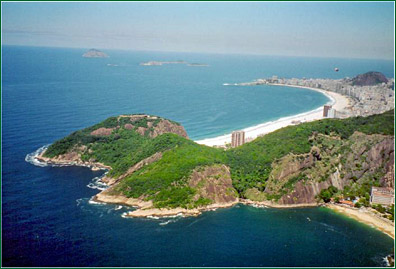 |
|
covers Leme hill, Urubu hill and Cotunduba Isle, has being recuperated
since l987. Turning around the hill, by the road which brings to Duque de Caxias fortress place at 130m altitude, in a way 1.000m long, we can come across to some species of native orchids. Until now, seven species have been found: Brassavola tuberculata Hook, Cyrtopodium sp. Epidendrum denticulatum, Habenaria leptoceras Hook, Oeceoclades maculata (Lindl.) Lindl. Sophronitis cernua Lindl. and Vanilla probably bahiana Hoehne. This survey has been done during just two visits, at the end of March 2004, so, it is far from being an exhaustive list. The second visit was guided by Plínio Loures Senna, an enthusiastic defender of the environment, who knows this area very well. He is, in fact, the person who encouraged its recuperation and conservation and is the leader of this project. Just at the banks, next to the road, in a very shade area, we can find 4 species: Epidendrum denticulatum, Habenaria leptoceras Hook, Oeceoclades maculata (Lindl.) Lindl. and Vanilla sp. |
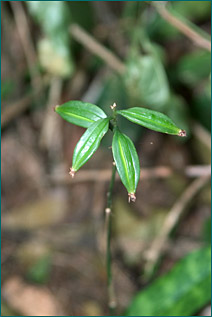 |
Oeceoclades maculata has already entirely colonized the ground along the road where it grows abundantly showing its light green mottled-leaves with floral stems and fruits, some of them bearing 8 capsules by stem. | 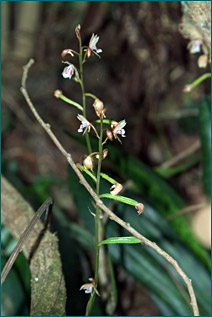 |
|
Vanilla grows on rock, almost all along the road, in the banks, winded around the shrub and also in Clusia tree. It is presumed to be "bahiana" since this species occurs in the neighbor hill, Urca, in Ben-te-vi way, as identified by Cláudio N. Fraga, Curator of the alive collections of the Botanical Garden of Rio de Janeiro. |
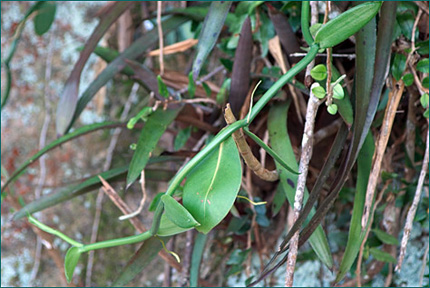 |
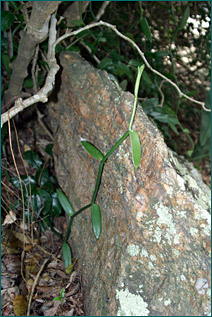 |
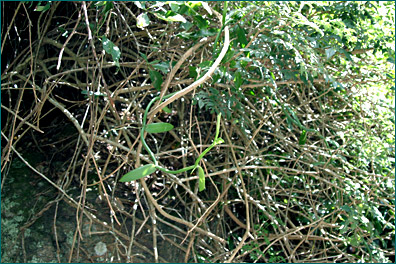 |
|
Although
not expected, there even is a specimen of Epidendrum denticulatum,
with dark green leaves, growing in a shade area on the rock.
In spite of being the blooming season, it is not flowering nor seems to have bloomed recently. 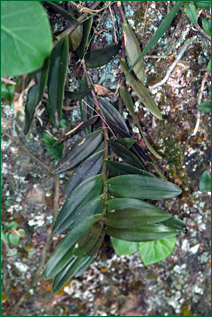 |
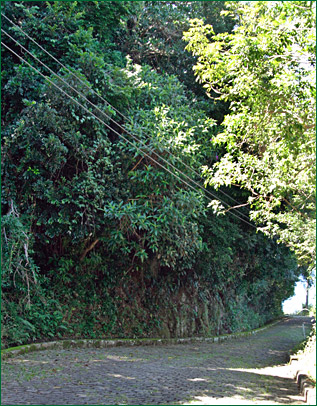 |
But the great surprise is Habenaria leptoceras with two colonies (the bigger one having 20 plants and the other, just three), with almost every individual blooming, growing in a thin layer of humus. |
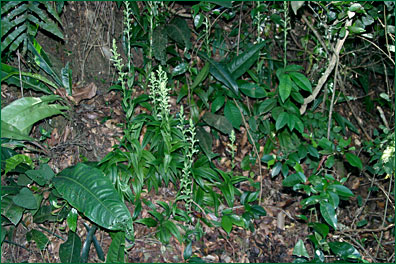 |
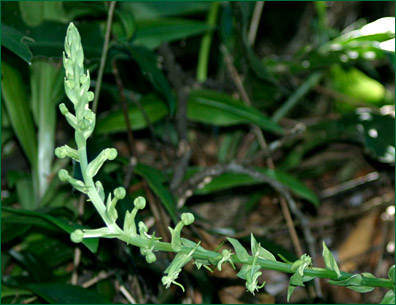 |
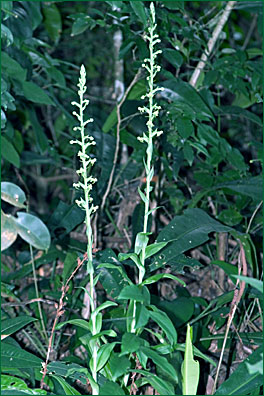 |
|
| In the rock hill side, in a very sunny place, there are Epidendrum denticulatum, Brassavola tuberculata and Cyrtopodium sp. |
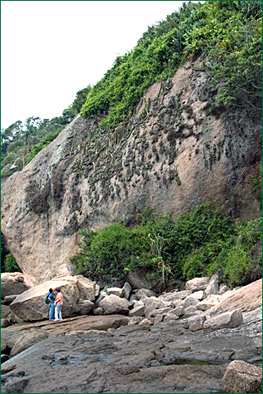 |
In
the east versant of Leme hill, next to Anel rock, in a very sunny place
which gets intense insolation since the dawn until part of the afternoon
and getting intense marine humidity, there is a great colony of Brassavola
tuberculata Hook. which blossom started very early this year and we
can see, by the end of March, the tufts of white stars. |
|
Just above the Brassavola tuberculata, in a place which is very
hard to get in, associated to the grass, there is a colony of Cyrtopodium
sp. The area where " Anel" is located and the trail to get there is the first one to be recuperated and who sees the exuberant vegetation of the wood nowadays, can't have an idea how it was completely colonized by the grass "colonião" (Panicum maximum) and, as a result, exposed to fires because the dried grass make the fire to propagate easily. |
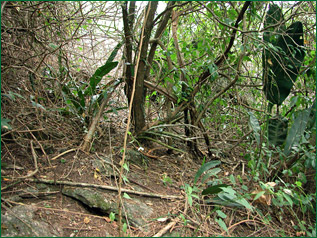 |
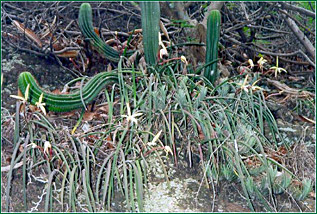 |
Above
this colony, in the same versant, at the edge of the way which brings
to fortress, SoAPA Leme(Society of Environmental Protected Area's friends"
replanted a small colony of Brassavola tuberculata rescued of a
disastrous fire provoked the festivities of the end of the year. Showing the slowness of its growing, years later, the colony remains small and bloomed for the first time, last year. As explained by Plínio Senna, "the plants which settle themselves to the rocky have a slow growing, taking years to formed colonies. They are provided by the thin ground formed there, the rainwater and the marine humidity. This is vegetation of restrict |
|
distribution, which has been threatened by the development of the city,
by the fires and colonization of colonião-grass and by the collecting,
mainly orchids and bromeliads". Albertoa 2(15): 144. 1993. |
|
Just above the Brassavola tuberculata, entirely exposed to the sun, there is a blooming colony of Epidendrum denticulatum, growing associated to another plants and sharing its space with Velozia Pleurostima purpurea Raf. a threatened species and endemic to this region (which also includes the Urca Hill, Ben-te-vi way, Orchid News # 22). |
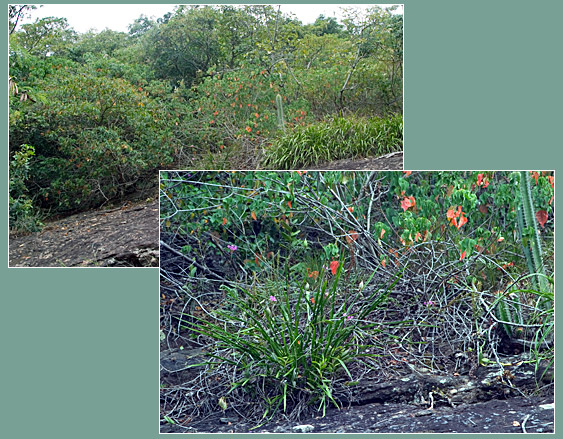 |
|
Next to this place, in the other side of the road, there was a small and
exuberant colony of Cyrtopodium growing in full sun. With the reforestation,
this colony became protected from the sun as a result, never bloomed again
and presenting a regression in its vegetative situation. SoAPA Leme has
already started to move it, putting some cuttings scions in sunny places
where they could develop in all their potentiality. |
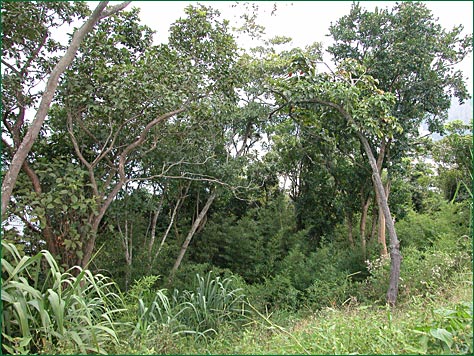 And, last but not least, in the top, just in front of the fortress, in an arboreous area, in a group of trees with thin trunks and medium height, we can find some colonies of Sophronitis cernua Lindl. |
continue |
